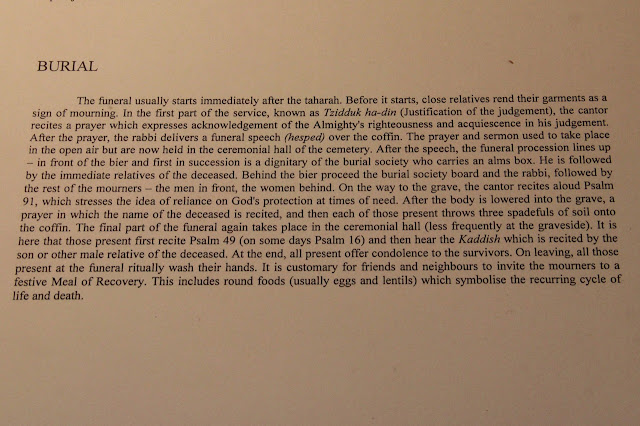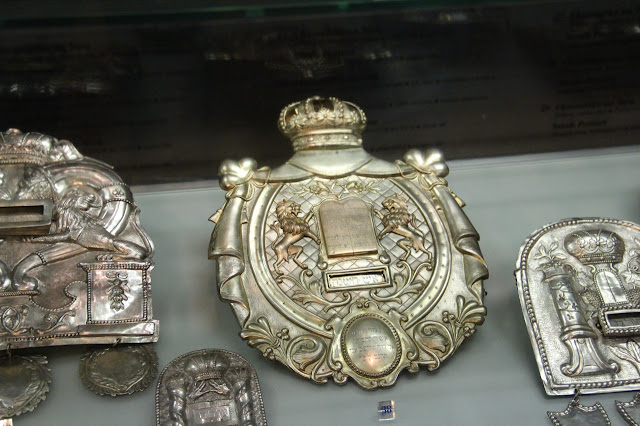This is it, our last day to enjoy the splendors of
Prague. We know our way around fairly
well and head across the Old Town Square without even having to think about
it! What in the world is going on in the
square?? There are brides
everywhere! And each has her own
photographer! But it isn’t very bright
and there aren’t any lights or reflectors or anything!
Marilyn can’t stand the suspense and asks one of the young
men what is going on. Is it a shoot for
a bridal magazine? “No”, he replies in
perfect English, “It’s a group honeymoon!”
There are seven couples who all got married at home in Japan and have
come to Prague on their honeymoons because the backgrounds for their photos are
so magnificent!! They are all having a
ball and the girls get more use out of their wedding dresses!
Although we’ve walked through most of the Old Quarter, in
which the Jewish Quarter is located, we are still finding new street to explore
and this morning we finally find a store that only sells handmade Czech
crafts. Of course this requires a
stop-and-shop! Great beginning to our
last day in this architectural fairyland! And there are always new details by which we are delighted!
With more bags and less cash, we’re on our way. The tickets are sold just outside the Pinkas
Synagogue. You can choose how many sites
you want to visit and if you want to take photographs there is an extra charge
of 70 Krona (less than three dollars).
The walls of the synagogue are covered in neatly written
names of all the Jews from Prague and the nearby towns who were exterminated in
the camps. They are arranged by family
with hometowns being written in ochre, family names in red, and individuals.
first names, dates of birthday, and last date on which they were known to be
alive written in black. When the
Communists took over, they obliterated nearly everything; but with the return of freedom the names were
all rewritten. In just a couple of places
you can see the original lettering and the desecration.
 |
| "Darkness" |
 |
| "Butterflies" |
 |
| "Flying" |
 |
| "To the Train Station" and the artist |
From here, one visits the Old Jewish Cemetery. For about three hundred and fifty years (1439
– 1787) this small place was the only burial ground for the Jewish
community. As a result, tombs were piled
one atop another with the resultant crowding and upheaval, and a plateau was
eventually created. The path curves
among the stones leaning against one another with lettering all but erased by
time.
 |
| Alms boxes |
 |
| Burial Society beaker |
 |
| Torah Shield |
 |
| Non-smoking Section! |
For the first time we’re asking if we want the smoking or
non-smoking section! Our section turns
out to be two whole tables! But the
servers are charming and the homemade soups, carrot and tomato, and the salads,
tuna and Greek are huge and fresh. And
of course the fresh breads to dip in olive oil and balsamic vinegar could have
been a meal by itself!
 |
| For those who don't remember Golem's story. |
 |
| See how close some of the Museum's components are. |
Heading back to finish the Klaus Synagogue we run the
gauntlet of souvenir stalls. Upstairs in
the Synagogue the exhibits center on the rituals of life, weddings, bar and bat
mitzvahs, circumcisions and kosher eating.
 |
| Spice boxes |
The Old-New Synagogue has been the most important synagogue
in the city for more than seven hundred years.
It was built in 1270 and you have to go downstairs to reach the 13th
century level of this Gothic building.
It’s the oldest synagogue in Eastern Europe. I found it fascinating
that, since Jews were not allowed to build, the synagogue was built by the
Christians, who also built the St. Agnes Convent nearby!
At last! Franz Kafka's statue!
The Spanish Synagogue is a couple of blocks away and Marilyn
isn’t so sure we need one more synagogue.
Being my parents’ child, I figure that we’ve paid for it and we ought to
go see it! Boy are we glad we did. Prior to this, we’ve been comparing the gilt
and glitter of all the cathedrals and basilicas we’ve seen with the relative
austerity of these synagogues. The
Spanish Synagogue dispels this view. While it will never match the Christian
displays, it is quite striking and beautiful.
The Moorish influence is obvious, especially noticeable in the shape of
the windows.
 |
| Torah Crown |
 |
| There are so many artifacts and memories. |
 |
| "Do a mitzvah today!!" |
Back through Old Town Square and one last chance at the
perfect photo! And we finally have our
definition of Shisha confirmed. It’s a
hookah! Many cafes offer them.
 |
| Giggle! |
 |
| The Tyn Church, finally, in decent light! And the clock, too! |
We head upstairs at OPH and begin the arduous task of
packing. Marilyn orders a ride from the
Prague Airport Shuttle to pick us up at 7:30 in the morning. That should give us an hour to arrive and two
hours before take off. We check in to
our flight online and I receive my first texted boarding pass! I’m really nervous without my trusty piece of
paper; but it will be another adventure!
The plan had been to return to the terrace restaurant around
the corner for another bottle of that lovely wine and, possibly, dessert. But when we get outside, it just seems like a
better idea to go to the little café right next door. There is only one table open outside and it
means we have to claim it away from the couple sitting at its twin. They are very gracious and we move what is
now our table a bit away from theirs so as to give us all our personal space.
We order a pitcher of sangria and are waiting patiently when
our server returns to say they are out of (something??) and can’t make the
sangria. We order a bottle of Riesling
instead. Then the pitcher of sangria
appears! At this point we begin to chat with our neighbors, Leena and Jeri. They are from Finland and live in the middle
of the country, near the Russian border.
They say it isn’t scary and that, in fact, the Russians buy houses in
Finland!
The food choices are pretty limited and all three of the
ladies order the bread bowl filled with goulash. Jeri ordered something blindly because it was
the only thing that didn’t have mustard in or with it! It turns out to be a meat and cheese plate
and looks yummy! We compare notes on
what we have seen and done and help them get oriented. Funny to be able to help someone else in a
city we’ve just “met”!
Back to the room and all those final preparations.
Everything is ready and maybe, just maybe, it will be quiet enough to sleep.












































































No comments:
Post a Comment